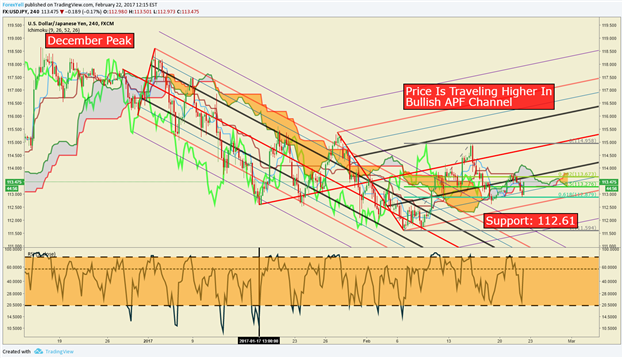Talking Points:
- USD/JPY Technical Strategy: watching following price move from 112.61 to build bias
- Previous Post: USD/JPY Technical Analysis: An Intermarket and Technical Powderkeg
- SSI is currently +1.6056 onUSD/JPY as 62% of retail traders are currently long: To stay up with the Speculative Sentiment Index, please click here.
- If you are looking for trading ideas, check out our Trading Guides
There is a lot going on with correlated markets to USD/JPY that should keep your attention. Many traders are familiar that the VIX, which remains near historically low levels of 12 is inversely correlated to USD/JPY or positively correlated to the JPY due to the unwind of the Carry Trade. The VIX is the SPX500 Implied Volatility Index, also known as the fear barometer, so a higher VIX implies more fear and therefore wider possibilities for SPX500 prices over the coming year. The combination of a low VIX and high or “overbought”SPX500 aligns, most often, with a stronger JPY and lower USD/JPY. The persistent decline in the VIX has seen USD/JPY bound around 112.
We noted in the recent article title, USD/JPY Technical Analysis: An Intermarket and Technical Powderkeg, that there is a lot going on behind the scenes that could cause USD/JPY to move and move big. Another positively correlated market is UST Yields, which have been unable to breakout higher (bond prices pushed lower) but have received news that the Fed appears ready to hike multiple times in 2017 as they are sitting near the targets of both mandates of price stability (inflation at 2%) and full employment.
Interested in Joining Our Analysts, Instructors, or Strategists For a Free Webinar? Register Here
Many traders may look at these events and think that we’re about to see a breakout in the VIX and that the S&P at all-time highs means that a crash is imminent. While the future is unknown by definition, one should be a caution to attribute a fixed outcome to the future as the VIX seems to show less fear than in times past. If this is correct, we could continue to see the SPX500 push higher alongside USD/JPY finding upside traction.
Looking at the chart below, you can see that the price of USD/JPY is no longer trading within the Bearish countertrend channel. The price move higher in mid-February has seemed to put USD/JPY on an upward trajectory with price support near 112.61/88 that should hold our attention.
If the VIX remains lower, and the price of USD/JPY continues to trade above 112.61, we can begin to subtly shift our bias higher, which would be validated on a break above 115. A move above 115 in USD/JPY would align with a nice continuation move in the newly drawn Andrew’s Pitchfork as well as show a breakout above the Daily Ichimoku Cloud.
Conversely, a breakdown and close below the early February low of 111.59 would keep us neutral as USD/JPY continues to correct a multi-year uptrend. The takeaway is that even though the VIX seem ready to breakout and the SPX500 appears overbought per RSI going back multiple decades; it could be an expensive mistake to presume we’re about to see a breakdown in USD/JPY and try and short the pair without validation of a move below 111.594. If the price can work it’s way higher in Andrew’s Pitchfork that is biased higher, my bias will be higher as well.
H4 USD/JPY Chart: USD/JPY Trading Above Counter-Trend Bearish Channel & Recent Range 61.8% Fibo

Chart Created by Tyler Yell, CMT
---
Shorter-Term USD/JPY Technical Levels: February 22, 2017
For those interested in shorter-term levels of focus than the ones above, these levels signal important potential pivot levels over the next 48-hours.

Contact and discuss markets with Tyler on Twitter: @ForexYell







